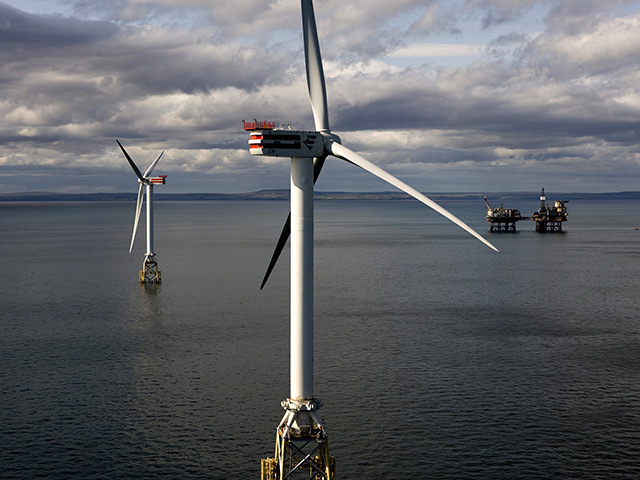
The Scottish Government has granted consent for four major offshore wind farms that could generate enough energy to power 1.4 million homes.
The developments in the Forth and Tay regions will include hundreds of turbines said to be capable of producing up to 2.284 gigawatts (GW) of electricity.
It is estimated that the four wind farms combined will produce carbon savings of 135 million tonnes of CO2 over their lifespans.
The announcement has been welcomed by some environmental groups, although RSPB Scotland raised fears the turbines would threaten marine wildlife.
The Scottish Government said consent has been granted subject to strict conditions to minimise the impact on birds and the environment.
The SNP administration has set a target of meeting 100% of Scotland’s electricity demand from renewable sources by 2020.
Energy Minister Fergus Ewing said: “Renewable energy is extremely valuable to Scotland’s economy, to reducing our carbon emissions and in providing low carbon energy supplies as well as jobs and long term investment.
“These wind farms alone could generate a combined gross value added of between £314 million and £1.2 billion in Scotland over their lifetime and generate between 2,567 and 13,612 jobs within Scotland during the construction period.”
The granting of the consents means developers will be able to bid for an offshore wind contract for difference (CfD) under the UK Government’s Electricity Market Reform process.
Mr Ewing added: “The budget for offshore wind (and other less established technologies) in the first of these rounds scheduled for autumn is £235 million, thought to be enough to support around 800 MW of offshore wind in UK waters.
“The level of support available to the offshore renewables sector sits in stark contrast to the unprecedented financial backing being offered to new nuclear plants, with a possible £35billion subsidy for the new Hinkley Point C station alone in addition to a £10 billion loan guarantee.
“This inevitably means that growth in green energy will be restricted, a sector where Scotland has a competitive advantage.”
Maggie McGinaly, director of energy and clean technologies at Scottish Enterprise, said: “As well as the significant electricity generation created by these sites, developers will now be able to move forward with these projects, bringing opportunities for new investment – and critically new jobs.”
Dr Richard Dixon, director of Friends of the Earth Scotland, welcomed the announcement as a “big step forward” but warned the “lack of enthusiasm” for renewables on the part of the UK Government meant the wind farms may never be built.
He said: “Developing our huge offshore wind potential on a large scale is crucial for meeting Scotland’s ambitious climate and energy targets.
“Just these four developments could supply two-thirds of Scotland’s electricity needs with clean, green energy on windy days. These schemes represent as much capacity as Scotland’s current nuclear reactors.
“The UK Government needs to stop its obsession with nuclear power skewing the electricity market to the major disadvantage of renewable energy.”
Stuart Housden, director of RSPB Scotland, said the charity was “extremely disappointed” with the decision.
He said: “If the models and assessments of potential damage prove accurate, these wind farms would be amongst the most deadly for birds anywhere in the world.
“RSPB Scotland wants to see the development of offshore wind in Scotland but it must not be at such massive cost to our internationally important seabirds.”
The Neart na Gaoithe wind farm off the Fife Ness coastline would have a maximum of 75 wind turbines generating up to 450 megawatts (MW) of power.
Eddie O’Connor, chief executive of the wind farm’s developer Mainstream Renewable Power, said: “Today’s announcement is of particular importance for Scotland because it is the first time a wind farm will be built in Scottish waters with the purpose of supplying Scottish homes and businesses with renewable energy. In fact, it will generate enough green power to supply more than all the homes in Edinburgh.”
The Alpha and Bravo Seagreen developments would be located east of the Angus coastline and would consist of up to 150 wind turbines with a generating capacity of up to 1050 MW.
The Inch Cape wind farm, also to the east of the Angus coastline, would have up to 110 wind turbines generating up to 784 MW.
Lindsay Leask, senior policy manager at Scottish Renewables, said: “This announcement comes after years of hard work, including the production of extensive environmental surveys, from all the developers involved.
“All commercial-scale Scottish offshore wind projects now have consent, and have the potential to generate up to 4.15 GW of clean electricity – enough to power up to three million homes
.
“The focus now moves on to whether developers can access a Contract for Difference – the new support mechanism for nuclear, renewables and carbon capture and storage – which the backers of the projects need to finalise their investments.”
Ronnie Quinn, lead for energy and infrastructure in Scotland for the Crown Estate, said: “As manager of the UK seabed we are delighted to see such positive decisions coming through the planning process, further cementing the UK’s position as a global leader in offshore wind and continuing to attract investors to Scotland.”
Recommended for you
